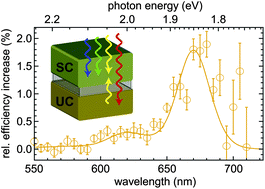Researchers based in Australia have found a way to convert more of the energy from the sun into useful energy, without massively increasing the cost of the process.
Currently photons with energy below a certain threshold are not picked up by most solar cells, but by combining two photons to make a single photon of higher energy (upconversion) more of the incoming radiation can be utilized.
Schmidt, Lips and co-workers describe a hydrogenated amorphous silicon (a-Si:H) solar cell backed by a layer of palladium porphyrin capable of upconverting photons, which are then able to be radiated back into the a-Si:H layer and converted to useful energy.
Read this HOT paper in full today:
Improving the light-harvesting of amorphous silicon solar cells with photochemical upconversion
Yuen Yap Cheng, Burkhard Fückel, Rowan W. MacQueen, Tony Khoury, Raphaël G. C. R. Clady, Tim F. Schulze, N. J. Ekins-Daukes, Maxwell J. Crossley, Bernd Stannowski, Klaus Lips and Timothy W. Schmidt
Energy Environ. Sci., 2012, DOI: 10.1039/C2EE21136J











